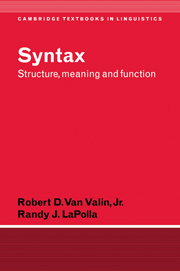Book contents
- Frontmatter
- Contents
- List of figures
- List of tables
- Acknowledgments
- Notes for instructors
- List of abbreviations
- 1 The goals of linguistic theory
- 2 Syntactic structure, I: simple clauses and noun phrases
- 3 Semantic representation, I: verbs and arguments
- 4 Semantic representation, II: macroroles, the lexicon and noun phrases
- 5 Information structure
- 6 Grammatical relations
- 7 Linking syntax and semantics in simple sentences
- 8 Syntactic structure, II: complex sentences and noun phrases
- 9 Linking syntax and semantics in complex sentences
- Epilog: the goals of linguistic theory revisited
- Notes
- References
- Index of languages
- Subject index
6 - Grammatical relations
Published online by Cambridge University Press: 05 June 2012
- Frontmatter
- Contents
- List of figures
- List of tables
- Acknowledgments
- Notes for instructors
- List of abbreviations
- 1 The goals of linguistic theory
- 2 Syntactic structure, I: simple clauses and noun phrases
- 3 Semantic representation, I: verbs and arguments
- 4 Semantic representation, II: macroroles, the lexicon and noun phrases
- 5 Information structure
- 6 Grammatical relations
- 7 Linking syntax and semantics in simple sentences
- 8 Syntactic structure, II: complex sentences and noun phrases
- 9 Linking syntax and semantics in complex sentences
- Epilog: the goals of linguistic theory revisited
- Notes
- References
- Index of languages
- Subject index
Summary
Introduction
At the beginning of chapter 2 we stated that there are two types of structure, relational and non-relational. As the labels imply, relational structure deals with the relations that exist between one syntactic element and another, be they syntactic, semantic or pragmatic in nature, whereas non-relational structure expresses the hierarchical organization of phrases, clauses and sentences. Non-relational structure was the focus of chapter 2, while semantic and pragmatic relational structures were the topics of chapters 3–5. In this chapter we turn to syntactic relations, or, as they are better known, grammatical relations. We will begin by looking at some of the conceptions of grammatical relations that have been proposed by different linguistic theories and the implications for theory and analysis of each of the major conceptions, then we will discuss the cross-linguistic diversity of syntactic phenomena related to grammatical relations and propose an account of grammatical relations which deals with this diversity.
Conceptions of grammatical relations
Grammatical relations are a part of traditional grammar. They are important because if one thinks pretheoretically, or as pretheoretically as one can, it is obvious that there are a lot of syntactic phenomena that relate to grammatical relations. For example, if one considers what the -s is doing on the third person singular present tense verb in English, it is clear that it is agreeing with the subject. Notice that this innocuous statement presupposes a theory of grammatical relations of some kind.
- Type
- Chapter
- Information
- SyntaxStructure, Meaning, and Function, pp. 242 - 316Publisher: Cambridge University PressPrint publication year: 1997

